![]()
Lord Vishnu is one of the three divine beings in the Trimurti and is known for his role as the sustainer of the universe. In this article, we are going to discuss the ten avatars of Vishnu, commonly referred to as the Dashavatar or Dashavataram. Lord Vishnu resides in Vaikuntha loka, also known as the spiritual realm, where he is referred to as Narayana. Krishnaloka, on the other hand, is considered the supreme planet of the spiritual world and is believed to be the transcendental abode of Krishna. This abode is divided into three sections, namely Dwarka, Mathura, and Goloka. In Krishnaloka, Krishna manifests himself into four plenary expansions, namely Krishna, Balarama, Pradyumna, and Aniruddha.
Balarama, who resides in Krishnaloka, is considered the original Sankarshana and is the source of Maha-Sankarshana, who resides in the Vaikuntha planets. It is Maha-Sankarshana’s responsibility to maintain the planets in the spiritual sky. Maha-Vishnu, who lies on the causal ocean and is the source of all universes, is an expansion of the Sankarshana.
Garbhodakasayi Vishnu is an expansion of Maha Vishnu and enters each universe to create Brahma, the first living creature of the universe. Garbhodakasayi Vishnu further expands into Ksirodakasayi Vishnu, who exists in the heart of every living entity as the Supersoul. Within the ocean of milk, there exists the island of Svetadvipa which is the abode of Ksirodakasayi Vishnu. Ksirodakasayi Vishnu descends to preserve the material world and vanquish the principles of irreligion, millennium after millennium. The below is stated in Bhagavad Gita regarding Lord Vishnu and his incarnations.
paritranaya sadhunam
vinasaya ca duskrtam
dharma-samsthapanarthaya
sambhavami yuge yuge
(Bhagavad Gita 4.8)
–
Millennium after millennium, I incarnate myself to deliver the pious, annihilate the miscreants, and reestablish the principles of dharma (religion).
#1 First Avatar : Matsya (Fish)
Matsya Avatar is the first of the ten avatars of Vishnu. In the previous millennium (Svayambhuva Manvantara), Lord Brahma slept, and the water of devastation flooded the three worlds, leaving only Brahmaloka and a few higher planets untouched. During this time, the demon Hayagriva tried to steal the Vedas emanating from Brahma’s mouth, and Lord Vishnu assumed the form of Matsya Avatar (fish incarnation) to rescue the Vedas by killing the demon. In the Chakshusha Manvantara, Matsya Avatar appeared again to bestow his favor upon King Satyavrata, who protected the fish that was, in fact, the Supreme Lord. The fish instructed the King to collect all types of herbs, seeds, animals, etc., and load them onto a large boat, which would appear before the king at the time of the heavy rains that would flood the three worlds. The King was accompanied by the seven celestial sages, and Lord Matsya guided the vessel within the water of inundation until Brahma woke up, and the water subsided.

#2 Second Avatar : Kurma (Turtle)
Lord Vishnu appeared as Kurma Avatar or in the form of a tortoise during the sixth Manvantara. Sage Durvasa cursed Indra after he insulted him, causing the demons to defeat the demigods in a battle. Following Lord Brahma’s advice, the demigods headed to the boundary of Svetadvipa and prayed to Lord Vishnu, who suggested that both the demigods and demons should churn the ocean of Milk together to produce the nectar of immortality. The truce between the demigods and demons was made, and the churning began using Mandara mountain and Vasuki serpent. After some time, the mountain began sinking into the ocean, but Lord Vishnu appeared as the Kurma Avatar and lifted the mountain on His back. While the great mountain was being churned on His back, the Lord merely felt an itching sensation.
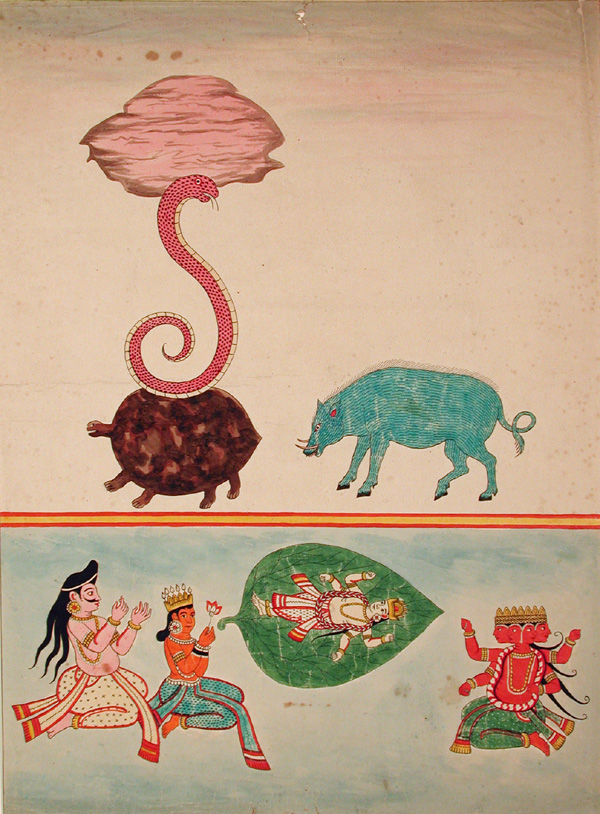
#3 Third Avatar : Varaha (Boar)
The Varaha avatar is the third incarnation of Lord Vishnu. In this form, Lord Vishnu takes the form of a boar to protect the Earth, which had sunk to the depths of the Garbhodaka ocean. The story begins with the four Kumaras, Sanaka, Sanatana, Sanandana, and Sanat Kumara, who visit Vaikuntha and meet two guards, Jaya and Vijaya, outside the seventh gate. The guards stop them, and this enrages the sages who curse the guards to be born in the material world. Lord Vishnu comes to know of the situation and explains that this was ordained by him. The guards are soon born in a demoniac family as Hiranyaksha and Hiranyakashipu. Hiranyaksha challenges Lord Vishnu in his Varaha form to a duel and wants to smash the Lord’s skull with his mace. Lord Vishnu tolerates his words and places the earth within His sight on the surface of the ocean. After a long fight, Lord Vishnu defeats Hiranyaksha and saves the Earth.
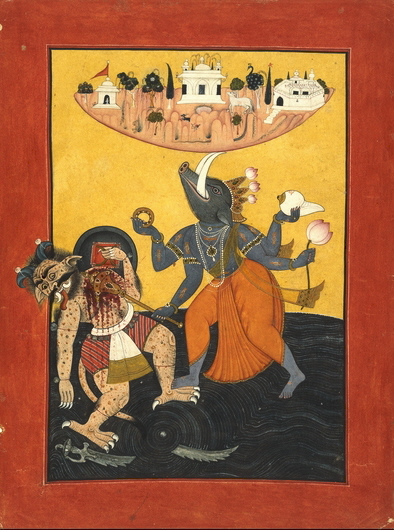
#4 Fourth Avatar : Narasimha (Man-Lion)
Hiranyakashipu, the brother of Hiranyaksha, was a demon fueled by revenge who wanted to become the Lord of the entire creation by killing Hari, the Supreme Lord who had slain his brother. Lord Brahma granted him the boons that he would not be killed in either the day or night, in either land, air or water, by any man or beast, by any weapon, either inside or outside his residence, thus making him almost immortal. Hiranyakashipu wreaked havoc by conquering all three worlds in this material universe. However, Prahlada, his son, a great devotee of the Supreme Lord, became his enemy by remaining fixed in his determination to serve Lord Hari. Prahlada enunciated the nine processes of devotional service: hearing the Lord’s glories, chanting His holy name, remembering the Lord, serving His lotus feet, offering the Lord respectful worship with sixteen types of paraphernalia, offering Him prayers, becoming His servant, becoming His friend, surrendering unto Him.
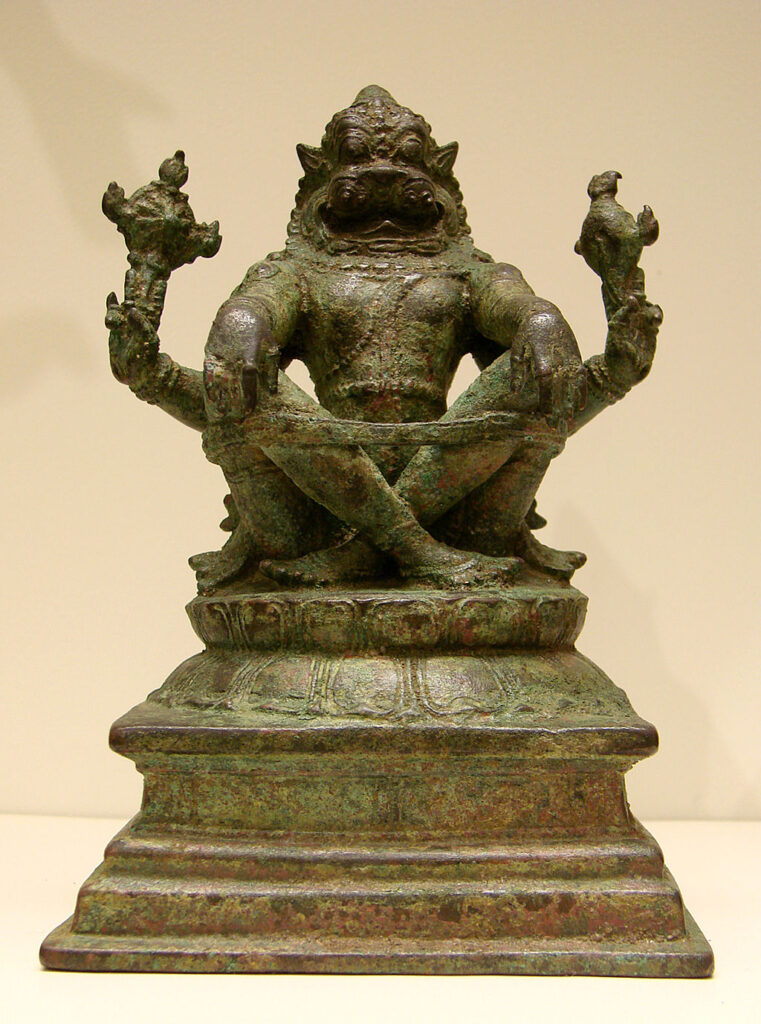
Hiranyakashipu ordered his servants to kill Prahlada, but no matter how laboriously they tried, they could not kill him. When none of his attempts to kill Prahlada worked, Hiranyakashipu grew very alarmed and enquired as to where Prahlada had received his superhuman powers. Prahlada gently replied that he had received his strength from the same place that his father had received his – from Sri Hari. On hearing his reply, Hiranyakashipu became more enraged and asked Prahlada where his God was. Prahlada answered that God was everywhere. In a fit of rage, the demon then started pointing to different things in the palace and asked his son whether God existed in them. Finally, pointing to a pillar nearby, he asked whether his ‘so-called’ God was present in it. When Prahlada responded in the affirmative, Hiranyakashipu took up his sword and smashed the pillar, as if in an attempt to kill the Supreme Lord. As soon as Hiranyakashipu smashed the pillar, Lord Narasimhadeva appeared from within. The wonderful fearsome form of the Lord, half-lion, half-man, killed Hiranyakashipu during twilight by placing the demon on his lap and uprooting his heart with his divine fingernails. Thus Lord Narasimha killed Hiranyakashipu without dishonoring any of the boons that Brahma had granted the demon.
#5 Fifth Avatar : Vamana (Dwarf)
Lord Vishnu’s fifth avatar, Vamana Deva, was born as the son of Aditi and sage Kashyapa. He appeared in his spiritual form, with four hands holding conch, club, lotus, and Sudarshan Chakra. He wore yellow garments, had a blackish complexion, wore jewelry, and adorned his bosom with Srivatsa and a garland of flowers. On Sravana Dvadasi, he transformed himself into a dwarf form and went to Bali Maharaja’s Ashwamedha Yajna. Bali welcomed him, washed his feet, and offered him anything in charity. Vamana Deva requested three steps of land, which Sukracharya warned Bali would lead to his destruction. But Bali refused to go back on his promise and Vamana Deva grew in size, covering the earth, sky, and all three worlds with his two steps. Bali then offered his head for Vamana Deva’s third step, which pushed him to the netherworlds. Vamana Deva blessed Bali and made him the king of the netherworld.
![]()
#6 Sixth Avatar : Parashuram (Warrior)
Parashurama is considered the sixth incarnation of Lord Vishnu and is known for his prowess as a warrior. He was born as the son of Jamadagni and Renuka and was a descendant of sage Bhrigu. Parashurama annihilated royals who turned irreligious and ignored the laws enacted by priests. Once, the King of the Haihayas, Kartaviryarjuna, became jealous of Jamadagni and stole his Kamadhenu cow. This angered Parashurama, who single-handedly fought and killed Kartaviryarjuna. When Parashurama’s mother, Renuka, became attracted to the King of the Gandharvas, Jamadagni ordered Parashurama to kill his brothers and mother. Parashurama did as he was told and asked his father to revive them later. Later, the sons of Kartaviryarjuna sought revenge and killed Jamadagni.
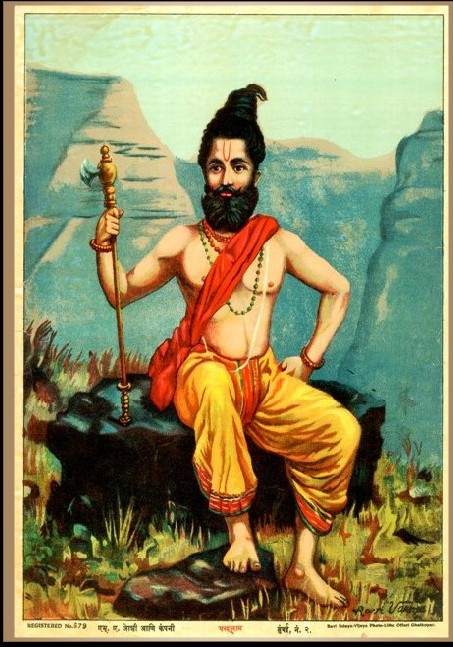
Parashurama then avenged his father’s death by killing all the sons of Kartaviryarjuna. After killing the sons of Kartaviryarjuna, Parashurama did not content himself with just that; he aimed to eradicate all the Kings from the face of the earth. He carried out his mission ruthlessly and wiped out the Kshatriyas twenty-one times. As a result, the earth became drenched in blood, and Parashurama created nine lakes filled with it. Later, after completing this mission, he performed the last rites of his father, who was elevated to become one of the seven sages in the group of celestial stars. According to Sukadeva Goswami, Lord Parashurama is destined to become one of the seven celestial sages in the coming millennium. At present, he has renounced all his weapons and lives a peaceful life as a wise Brahmana in the mountainous country of Mahendra. His extraordinary pastimes have earned him worship and adoration from the celestials.
#7 Seventh Avatar : Rama (Monarch)
The story is about King Dasharatha who had four sons headed by the eldest, Rama, and the latter’s exile. When the king decided to retire to the forest and hand over the kingdom to Rama, one of his wives, Kaikeyi, was convinced by a hunchbacked maid that the coronation was a plot to do away with her son, Bharat. Kaikeyi demanded that her own son be crowned instead of Rama and that Rama be banished to the forest for fourteen years. Bound by his promise, the king had no choice but to comply with Kaikeyi’s wishes. Rama, Sita, and Lakshman decided to live in the forest for fourteen years.

While there, Rama refused to marry the ugly ogress named Surpanakha, which led to a confrontation in which Lakshman stepped in and sliced off her nose and ears. Later, when Rama left to hunt a golden deer, Sita convinced Lakshman to leave her alone in the hermitage, which was a ruse by the demon Ravana, who abducted Sita to his kingdom of Lanka.After Sita’s abduction by the demon king Ravana, Rama, and his brother Lakshman searched for her with the help of an army of monkey warriors led by Sugriva. Hanuman, a monkey warrior, was sent to Lanka to find Sita and succeeded. Rama’s army built a bridge to Lanka and engaged in a fierce battle with Ravana’s forces. Rama ultimately defeated Ravana and rescued Sita. Upon their return, the citizens of Ayodhya celebrated with great joy, and Rama became a revered king. His reign was called Rama-Rajya, and his example as an ideal king is still remembered today.
#8 Eighth Avatar : Balarama (Cowherd)
Devaki and Vasudeva were imprisoned by Kansa, Devaki’s tyrannical brother, who intended to kill their eighth son, as he was told that he would be the cause of his own death. When Devaki became pregnant with her seventh child, Lord Balarama appeared in her womb, and Krishna instructed his yogamaya potency to move Lord Balarama to the womb of Rohini, one of Vasudeva’s wives. After Lord Balarama had prepared the womb, Devaki gave birth to Krishna, who became her eighth child. Balarama, who is the elder brother of Krishna, is renowned as the killer of the demon Pralambasura and has a captivating appearance with white crystal complexion, long hair, and adorned with jewels and flowers.
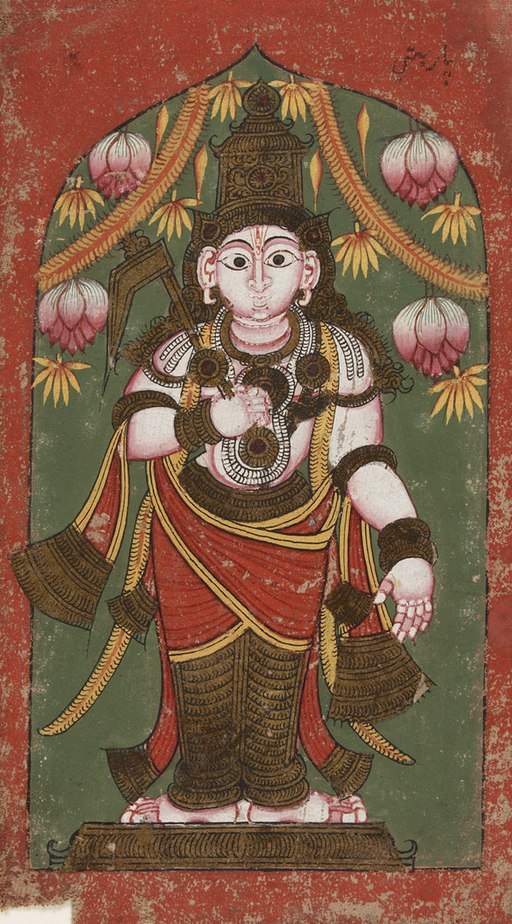
Five thousand years ago in India, Lord Krishna and His elder brother Balaram lived in the rural village of Vrindavan on the river Yamuna. They were both exquisitely beautiful with Krishna being bluish black and Balaram white. Krishna dressed in yellow and played a flute while Balaram wore blue and carried a plough. Krishna and Balaram’s father Nanda was in charge of the farming community and owned thousands of dairy cows. Krishna and Balaram would take the cows to graze in the pasturing grounds, where they and their friends would enjoy the forest atmosphere, playing and dancing. The milkmaids of Vrindavan, the gopis, were particularly fond of Krishna and waited eagerly for his return. Krishna and the gopis would playfully dance in the groves along the Yamuna River. One day, Krishna and Balaram left for Mathura and never returned, causing great grief for the residents of Vrindavan. Years later, Balaram visited Vrindavan and stayed for two months, pacifying the gopis by telling them stories of Krishna. One evening, Balaram wanted to bathe in the Yamuna, but the river refused, causing Balaram to become angry and threaten to scratch the river into hundreds of scattered streams with his plough. The river begged for forgiveness, and Balaram forgave her, and they all bathed together. In Balaram’s company, the gopis and other residents of Vrindavan became as cheerful as they had been before the two brothers left.
#9 Ninth Avatar : Buddha (Teacher)
namo buddhaya suddhaya daitya-danava-mohine
mleccha-praya-kshatra-hantre namas te kalki-rupine
(Srimad-Bhagavatam 10.40.22)
–
Obeisances to Your form as the faultless Lord Gautama Buddha, who will bewilder the miscreants by composing anti Vedic scriptures. I also offer obeisances to Lord Kalki, the annihilator of the barbarians posing as kings.
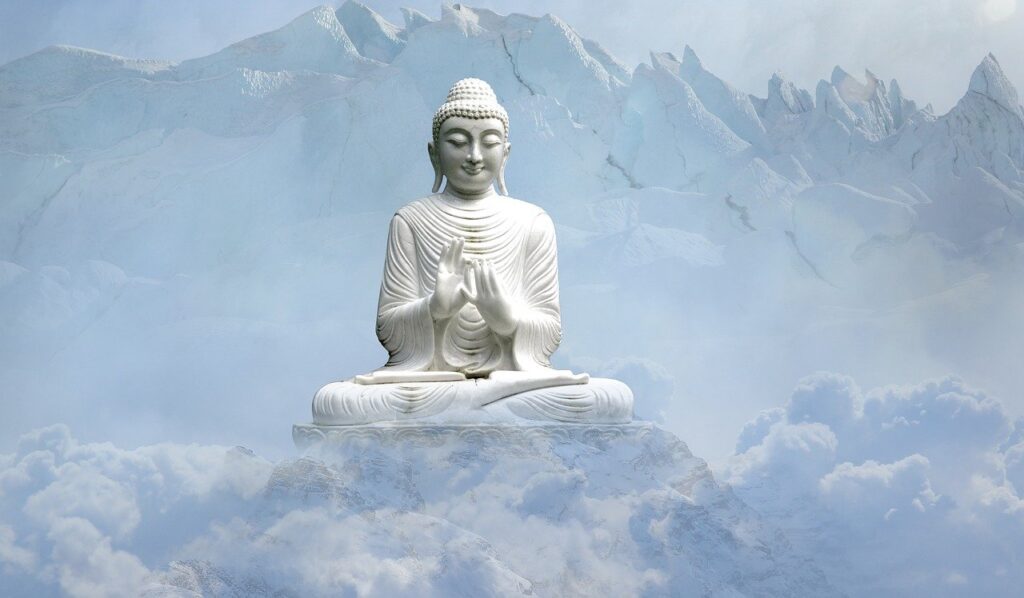
Gautama Buddha, also known as Siddhartha Gautama, was born in India around 600 years before Jesus Christ. His father was a ruler and his mother died shortly after his birth. Due to a prediction that he might renounce his kingdom, his father ordered that Siddhartha should never leave the palace grounds and should always be escorted by security guards. However, one day Siddhartha managed to escape and witnessed old age, disease, and death, which made him vow to solve the eternal problems of life. He chose the middle path of moderate living and renounced his worldly possessions to become an ascetic. Siddhartha then became ‘The Buddha’ after attaining enlightenment while meditating under a Bo tree. He became famous as a religious teacher and preached principles of compassion and non-violence. Lord Buddha also emphasized a strictly vegetarian diet to protect innocent animals.
#10 Tenth Avatar : Kalki (Slayer)
The Kalki avatar is an incarnation of the Supreme Lord predicted to appear at the end of the Kali Yuga, according to various Hindu scriptures. The Kalki avatar is said to be the son of Vishnuyasha, an eminent Brahmana, who will be born in the village of Shambhala. His mission will be to re-establish the postulates of eternal religion by annihilating the miscreants. The Vishnu Purana, Srimad Bhagavatam, and the Kalki Purana mention his birthplace and family details.
![]()
The symptoms of Kali Yuga include a decrease in religion, honesty, purity, kindness, and tolerance, and an increase in hypocrisy, lack of physical strength, and shortened duration of life. The institution of marriage will degenerate, and success will be achieved based on deception. Manliness and womanliness will be defined based on one’s expertise in sexual intercourse.
The Kalki avatar will end the age of Kali by killing all the wicked miscreants and unrighteous rulers and propounding the highest truth with the help of his four brothers. The transcendental glories of the Kalki avatar shall cleanse the hearts of those who hear them with devotion.
asvam asu gam aruhya
devadattam jagat patih
asinasadhu damanam
astaisvarya gunanvitah
vicharann asuna ksaunyam
hayenapratima dyutih
nripa-linga-cchado dasyun
kotiso nihanisyati
(Srimad Bhagavatam 12.2.19-20)
–
Lord Kalki, the Lord of the universe, will ascend His swift horse Devadatta and, carrying a sword in hand, travel over the earth exhibiting His eight mystic opulences and special qualities of Godhead. Unveiling His unmatched effulgence and riding with great speed, He will kill by millions those thieves who have dared dress as kings.
Note – Why Krishna is Not One of the Ten Avatars of Vishnu?
Krishna, being the source of Vishnu, is not included in the list of the ten avatars (incarnations) of Vishnu. This fact has been confirmed in various Vedic scriptures. It is explained that Krishna is the source of all other incarnations of the Supreme, although there is no distinction between Vishnu and Krishna, as they are the same person expressing different moods. Krishna is like the original candle that illuminates all other candles, being the original Supreme Person from whom others manifest. Despite the fact that everything emanates from the Supreme Being, He remains aloof from it all, engaging in His eternal pleasure pastimes with His devotees in the spiritual realm. Thus, in the process of creating the material worlds, Krishna expands Himself into various plenary forms.
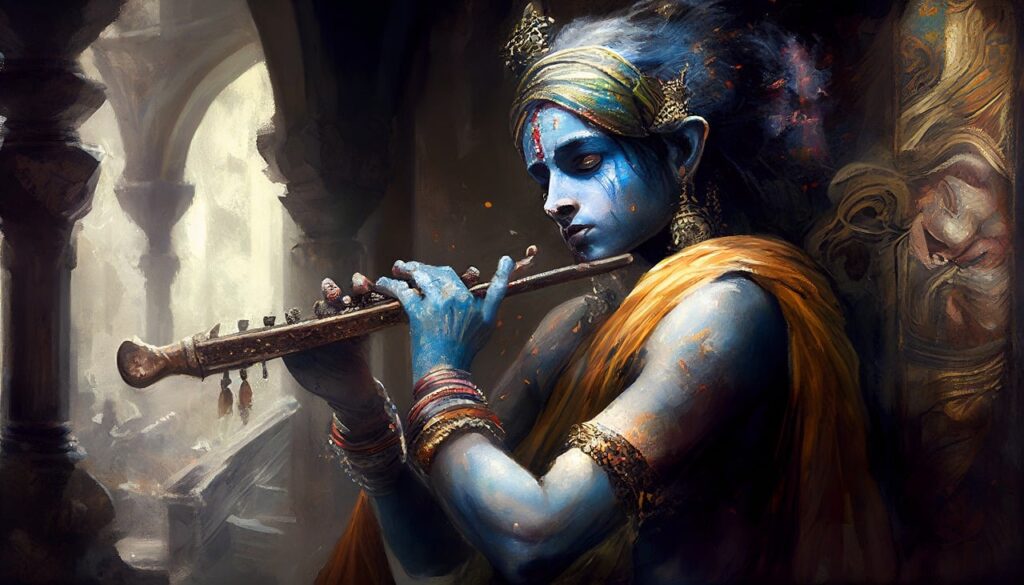
Ete camsa kalah pumsah krsnas tu bhagavan svayam
Indrari vyakulam lokam mrdayanti yuge yuge
(Srimad Bhagavatam 1.3.28)
–
All these incarnations are either plenary portions or portions of plenary portions of the Supreme Lord, but Lord Krishna is the original Supreme Personality of Godhead. All of His incarnations appear whenever there is a disturbance created by atheists. These incarnations appear to protect the theists.
This is also confirmed by Lord Brahma in his prayers :
Isvarah paramah krishna sac cid ananda vigrahah
Anadir adir govindah sarva karana karanam
(Brahma Samhita 5.1)
–
Krishna, who is also known as Govinda, is the Supreme Personality of Godhead. He has a transcendental form of eternal bliss and knowledge. He is the origin of all and the prime cause of all causes.
Deliverance in Kali Yuga
In this age of Kali, incessant chanting of the holy names of Lord Hari (Vishnu) is the only means by which one can be delivered from this material world. This is confirmed in various scriptures. For example, the Brhan Naradiya Purana states –
harer-nama harer-nama harer-namaiva kevalam
kalau nasty-eva nasty-eva nasty-eva gatir anyatha
(Brhan Naradiya Purana)
–
In this age of Kali the only means of deliverance is chanting of the holy name of Lord Hari. There is no other way. There is no other way. There is no other way.
Regular hearing and chanting the names and glories of Lord Hari, cleanses one’s heart and rekindles his/her love for the Supreme which is lying dormant in one’s heart. Of all the holy names of Lord Hari, the name ‘Krishna’ is the most complete and most potent. Hence Sri ‘Krishna Sankirtanam’ (congregational chanting of Krishna’s holy name) is the only religious practice in this dark age of Kali.